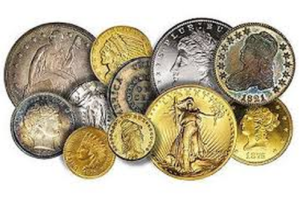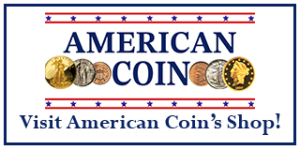
Identifying Coins from the U.S. Mint
The first task is to determine if your coin is on official product of the mint of the United States of America. If it is not, then this guide will not help you. To determine if your coin is a product of the U.S. Mint, Look for the following indicators:
- Do the words “United States of America” appear on the coin? Ninety-nine percent (99%) of all American coins have this text on them. You get extra credit if you can name a regular issue coin that doesn’t have this text on it.
- If the coin is dated after 1866 it will typically have the motto “In God We Trust” with some notable exceptions (cents particularly).
- Many coins since about the 1820s have “E Plurbus Unum” on the coin as well.
- Most coins since the 1820s have the denomination marked in “dollars” or “cents”.
Coins produced by the United States Mint fall basically into the following categories.
- Regular Issue Coins
- Proofs and Specimen Strikes
- Patterns
- Commemoratives
- Bullion Coins
- Philippines Coins
- Miscellaneous
- Not a Coin
Regular Issue Coins
A regular issue coin was struck by the mint for the express purpose of providing coinage for commerce. Nearly every coin you have ever spent falls into this category. These coins outnumber all other categories by hundreds to one. Nevertheless, many regular issue coins are extremely rare. We have provided an image gallery of Regular Issue Coins from the United States of America for you: Regular Issue Coins.
Proofs and Specimen Strikes
Proof and Specimen Strike coins were produced especially for collectors. Usually, they are struck twice to bring out the full design in great detail. In general, they are prettier than regular issue coins (given that it is a subjective aesthetic judgment). Normally, they are rarer, with some notable exceptions when regular issue coins were issued in extremely small numbers.
Patterns
A Pattern coin is essentially the result of a mint test. The mint has made coins when testing their equipment, different metals, or sometimes as approval pieces. Prior to this century, these patterns were often given away or sold by the mint and legitimately worked their way into the collector market. Occasionally, patterns were released in rather large numbers such as the 1,500+ 1856 Flying Eagle cents.
Commemoratives
Commemorative coins were produced for collectors. Most commemoratives are half dollars. They were minted from 1892-1954, and resumed in 1982-present. There was a commemorative quarter in 1893, and the circulating Bicentennial Commemoratives in the quarter, half and dollar denominations in 1976. There have been a few silver dollar commemoratives as well as a few gold commemoratives of various denominations including the only official $50 coin in the history of the United States. See Commemoratives for more details.
Bullion Coins
Bullion coins are all relatively recent. They were first made in 1986. These include the Walking Liberty Silver Dollar and several gold issues. Commemoratives and bullion coins (and most patterns) will still have “United States of America” somewhere on the design. All gold coins issued since 1934 are commemoratives, pattern or bullion coins. All silver coins issued since 1971 are commemorative, pattern, bullion or special collector coins. See Bullion Coins for more details.
Philippines Coins
When the Philippines was a territory of the United States, the U.S. made a short run of coins. Most are copper nickel mixes but a few of them are silver. See Philippines Coins for more details.
Miscellaneous
There are some coins that are clearly products of the U.S. Mint that do not fit neatly into one of the above categories. The famous 1913 V Nickel (the first coin publicly auctioned for more than US$1,000,000) wasn’t a presentation piece or a proof coin, yet it is clearly a mint product. Miscellaneous American coins are generally EXTREMELY rare.
Not a Coin
Your “coin” might also be a medal or token of some kind. Throughout the years, the U.S. Mint has produced inaugural medals, peace tokens, and such. Remember also, that during much of our country’s history, it was legal for banks and even business men to make their own coinage and paper money, as long as it wasn’t a counterfeit copy of a US design.
Identify Coins You Have
If you want to identify a coin in your possession, I would suggest beginning with the regular issues. If you can’t identify a coin from this guide, but still believe it to be a product of the United States mint, please Contact Us and we will be glad to help.


